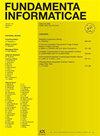基于决策粗糙集理论的自主知识聚类
IF 0.4
4区 计算机科学
Q4 COMPUTER SCIENCE, SOFTWARE ENGINEERING
引用次数: 38
摘要
在许多应用程序中,集群往往具有模糊或不精确的边界。聚类技术应该考虑这样一个问题。决策理论粗糙集(DTRS)模型是一种典型的概率粗糙集模型,具有处理不精确、不确定和模糊信息的能力。基于面向知识的聚类框架,提出了一种基于决策理论粗糙集模型的自主聚类方法。为了获得初始的面向知识的聚类,在没有人工干预的情况下,基于聚类的语义自主产生阈值。在此基础上,通过考虑各种损失函数,对基于决策理论粗糙集的聚类方案的风险进行估计,使其能够处理不同粒度的重叠边界。提出了一种自主聚类算法,该算法不仅对合成数据和标准数据进行了实验,而且将其应用于web搜索结果聚类。实验结果表明,该方法是有效的。本文章由计算机程序翻译,如有差异,请以英文原文为准。
Autonomous Knowledge-oriented Clustering Using Decision-Theoretic Rough Set Theory
In many applications, clusters tend to have vague or imprecise boundaries. It is desirable that clustering techniques should consider such an issue. The decision-theoretic rough set (DTRS) model is a typical probabilistic rough set model, which has the ability to deal with imprecise, uncertain, and vague information. This paper proposes an autonomous clustering method using the decision-theoretic rough set model based on a knowledge-oriented clustering framework. In order to get the initial knowledge-oriented clustering, the threshold values are produced autonomously based on semantics of clustering without human intervention. Furthermore, this paper estimates the risk of a clustering scheme based on the decision-theoretic rough set by considering various loss functions, which can process the different granular overlapping boundary. An autonomous clustering algorithm is proposed, which is not only experimented with the synthetic data and the standard data but also applied in the web search results clustering. The results of experiments show that the proposed method is effective and efficient.
求助全文
通过发布文献求助,成功后即可免费获取论文全文。
去求助
来源期刊

Fundamenta Informaticae
工程技术-计算机:软件工程
CiteScore
2.00
自引率
0.00%
发文量
61
审稿时长
9.8 months
期刊介绍:
Fundamenta Informaticae is an international journal publishing original research results in all areas of theoretical computer science. Papers are encouraged contributing:
solutions by mathematical methods of problems emerging in computer science
solutions of mathematical problems inspired by computer science.
Topics of interest include (but are not restricted to):
theory of computing,
complexity theory,
algorithms and data structures,
computational aspects of combinatorics and graph theory,
programming language theory,
theoretical aspects of programming languages,
computer-aided verification,
computer science logic,
database theory,
logic programming,
automated deduction,
formal languages and automata theory,
concurrency and distributed computing,
cryptography and security,
theoretical issues in artificial intelligence,
machine learning,
pattern recognition,
algorithmic game theory,
bioinformatics and computational biology,
quantum computing,
probabilistic methods,
algebraic and categorical methods.
 求助内容:
求助内容: 应助结果提醒方式:
应助结果提醒方式:


